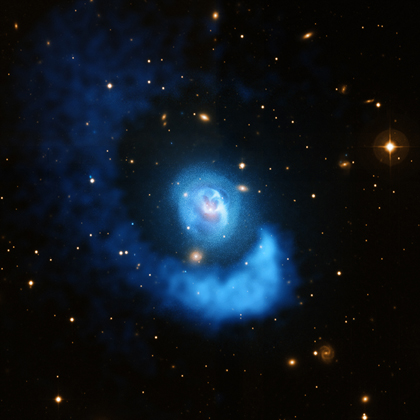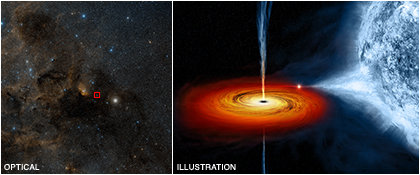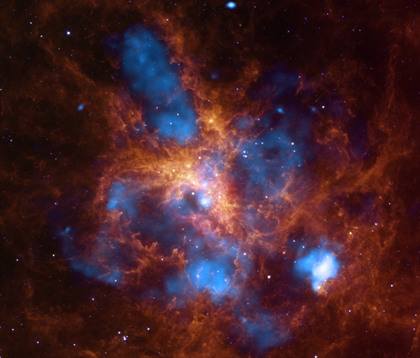Submitted by chandra on Tue, 2011-12-13 13:01

Like wine in a glass, vast clouds of hot gas are sloshing back and forth in Abell 2052, a galaxy cluster located about 480 million light years from Earth. X-ray data (blue) from NASA's Chandra X-ray Observatory shows the hot gas in this dynamic system, and optical data (gold) from the Very Large Telescope shows the galaxies. The hot, X-ray bright gas has an average temperature of about 30 million degrees.
Submitted by chandra on Mon, 2011-11-28 13:18
While most of us in the US were still digesting from the Thanksgiving holiday this past weekend, many folks at NASA were incredibly busy. That's because on Saturday, November 26th, NASA launched the Mars Science Laboratory (MSL) into space aboard an Atlas V rocket.
Submitted by chandra on Tue, 2011-11-22 18:04
Q: Can black holes move through space?
A: Black holes can indeed move through space. The really massive black holes at the centers of galaxies will stay there unless something catastrophic happens, like a direct collision between two galaxies.
Submitted by chandra on Thu, 2011-11-17 10:21

On the left, an optical image from the Digitized Sky Survey shows Cygnus X-1, outlined in a red box. Cygnus X-1 is located near large active regions of star formation in the Milky Way, as seen in this image that spans some 700 light years across. An artist's illustration on the right depicts what astronomers think is happening within the Cygnus X-1 system. Cygnus X-1 is a so-called stellar-mass black hole, a class of black holes that comes from the collapse of a massive star. The black hole pulls material from a massive, blue companion star toward it. This material forms a disk (shown in red and orange) that rotates around the black hole before falling into it or being redirected away from the black hole in the form of powerful jets.
Submitted by chandra on Thu, 2011-11-10 12:54

The star-forming region, 30 Doradus, is one of the largest located close to the Milky Way and is found in the neighboring galaxy Large Magellanic Cloud. About 2,400 massive stars in the center of 30 Doradus, also known as the Tarantula Nebula, are producing intense radiation and powerful winds as they blow off material.
Submitted by chandra on Thu, 2011-11-03 16:51
An era of space exploration ended on July 21, 2011 when Space Shuttle Atlantis touched down before dawn at Kennedy Space Center. The shuttle flights excited our imaginations and tragically revealed the dangers of space travel as mankind dipped its toes into the cosmic ocean. One of the most enduring legacies of the shuttle was established in the 1990's, when the shuttle delivered three of NASA's Great Observatories – Hubble Space Telescope, Compton Gamma Ray Observatory, and the Chandra X-ray Observatory – into space.
Submitted by chandra on Mon, 2011-10-31 11:35
Last week, the German Aerospace Center (DLR) issued this statement:
"On 23 October 2011 at 03:50 CEST, the German research satellite ROSAT re-entered the atmosphere over the Bay of Bengal; it is not known whether any parts of the satellite reached Earth's surface. Determination of the time and location of re-entry was based on the evaluation of data provided by international partners, including the USA."
Submitted by chandra on Thu, 2011-10-27 13:26
Submitted by chandra on Thu, 2011-10-27 12:25

This image combines data from four different space telescopes to create a multi-wavelength view of all that remains of the oldest documented example of a supernova, called RCW 86. The Chinese witnessed the event in 185 A.D., documenting a mysterious "guest star" that remained in the sky for eight months. X-ray images from NASA's Chandra X-ray Observatory and the European Space Agency's XMM-Newton Observatory are combined to form the blue and green colors in the image. The X-rays show the interstellar gas that has been heated to millions of degrees by the passage of the shock wave from the supernova.
Submitted by chandra on Wed, 2011-10-26 10:52
 Credit: Jonathan McDowell, SAO
Credit: Jonathan McDowell, SAOThis week, a new exhibit opened at the Smithsonian's National Museum of Natural History in Washington, DC. The "Evolving Universe" exhibit showcases many images from Chandra along with other telescopes and projects that involve the Smithsonian Astrophysical Observatory (SAO). This project, which can be found on the second floor of the museum, is a collaboration between these two branches of the Smithsonian, and gives visitors a chance to learn a little bit more about what happens at SAO's Cambridge, MA location. The exhibit will be on display now through January 20, 2012, so don't miss it.
Pages